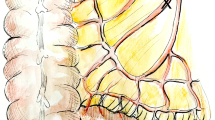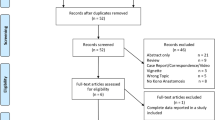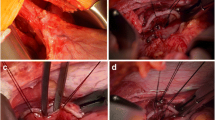Abstract
Introduction
Anastomotic recurrence is a frequent event after bowel resection for Crohn’s disease. To date, no anastomotic technique has been proven to be superior in reducing surgical recurrence rates in this setting. In this article, we describe our technique in performing a new antimesenteric functional end-to-end handsewn (Kono-S) anastomosis.
Methods
The segment of bowel to be resected is identified and mobilized. The bowel is then divided transversely with a linear stapler–cutter device. The intervening mesentery is divided close to the bowel. The corners of the two stapled lines are sutured together, and the two stapled lines are approximated with interrupted sutures. An antimesenteric longitudinal enterotomy is performed on both sides, starting no more than 1 cm away from the staple line, to allow a transverse lumen of 7–8 cm. The openings are closed transversely in two layers.
Results
From May 1, 2010 to July 31, 2011 we performed 46 Kono-S anastomoses. One patient had a contained anastomotic leak successfully treated conservatively. Currently, 18 patients (43 %) have undergone follow-up endoscopic surveillance with an average Rutgeert’s score of 0.7 (0–3) at a mean of 6.8 months.
Conclusion
The Kono-S anastomosis is a safe anastomotic technique. Long-term studies are needed to confirm its efficacy in preventing surgical recurrence.






Similar content being viewed by others
References
Fazio VW, Tjandra JJ, Lavery IC, Church JM, Milsom JW, Oakley JR. Long-term follow-up of strictureplasty in Crohn's disease. Dis Colon Rectum 1993;36:355–61.
Uchino M, Ikeuchi H, Bando T, Matsuoka H, Takahashi Y, Takesue Y, Matsumoto T, Tomita N. Risk factors for short bowel syndrome in patients with Crohn's disease. Surg Today 2011.
Fichera A, Michelassi F. Surgical treatment of Crohn's disease. J Gastrointest Surg 2007;11:791–803.
Yamamoto T. Factors affecting recurrence after surgery for Crohn's disease. World J Gastroenterol 2005;11:3971–9.
Munoz-Juarez M, Yamamoto T, Wolff BG, Keighley MR. Wide-lumen stapled anastomosis vs. conventional end-to-end anastomosis in the treatment of Crohn's disease. Dis Colon Rectum 2001;44:20–5; discussion 5–6.
Simillis C, Purkayastha S, Yamamoto T, Strong SA, Darzi AW, Tekkis PP. A meta-analysis comparing conventional end-to-end anastomosis vs. other anastomotic configurations after resection in Crohn's disease. Dis Colon Rectum 2007;50:1674–87.
Kono T, Ashida T, Ebisawa Y, Chisato N, Okamoto K, Katsuno H, Maeda K, Fujiya M, Kohgo Y, Furukawa H. A new antimesenteric functional end-to-end handsewn anastomosis: surgical prevention of anastomotic recurrence in Crohn's disease. Dis Colon Rectum 2011;54:586–92.
Rutgeerts P, Geboes K, Vantrappen G, Beyls J, Kerremans R, Hiele M. Predictability of the postoperative course of Crohn's disease. Gastroenterology 1990;99:956–63.
Michelassi F, Balestracci T, Chappell R, Block GE. Primary and recurrent Crohn's disease. Experience with 1379 patients. Ann Surg 1991;214:230–8; discussion 8–40.
Peyrin-Biroulet L, Loftus EV Jr, Colombel JF, Sandborn WJ. The natural history of adult Crohn's disease in population-based cohorts. Am J Gastroenterol 2010;105:289–97.
Terdiman JP. Prevention of postoperative recurrence in Crohn's disease. Clin Gastroenterol Hepatol 2008;6:616–20.
Fichera A, Lovadina S, Rubin M, Cimino F, Hurst RD, Michelassi F. Patterns and operative treatment of recurrent Crohn's disease: a prospective longitudinal study. Surgery 2006;140:649–54.
Sutherland LR, Ramcharan S, Bryant H, Fick G. Effect of cigarette smoking on recurrence of Crohn's disease. Gastroenterology 1990;98:1123–8.
Anthony A, Dhillon AP, Pounder RE, Wakefield AJ. Ulceration of the ileum in Crohn's disease: correlation with vascular anatomy. J Clin Pathol 1997;50:1013–7.
Angerson WJ, Allison MC, Baxter JN, Russell RI. Neoterminal ileal blood flow after ileocolonic resection for Crohn's disease. Gut 1993;34:1531–4.
Eysselein VE, Reinshagen M, Patel A, Davis W, Nast C, Sternini C. Calcitonin gene-related peptide in inflammatory bowel disease and experimentally induced colitis. Ann N Y Acad Sci 1992;657:319–27.
Cho SM, Cho SW, Regueiro M. Postoperative management of crohn disease. Gastroenterol Clin North Am 2009;38:753–62.
Author information
Authors and Affiliations
Corresponding author
Rights and permissions
About this article
Cite this article
Fichera, A., Zoccali, M. & Kono, T. Antimesenteric Functional End-to-End Handsewn (Kono-S) Anastomosis. J Gastrointest Surg 16, 1412–1416 (2012). https://doi.org/10.1007/s11605-012-1905-7
Received:
Accepted:
Published:
Issue Date:
DOI: https://doi.org/10.1007/s11605-012-1905-7




